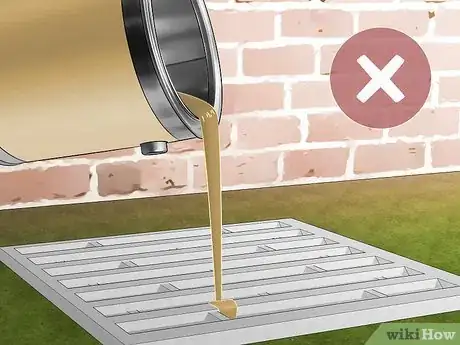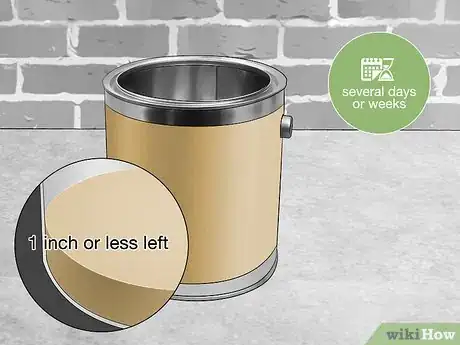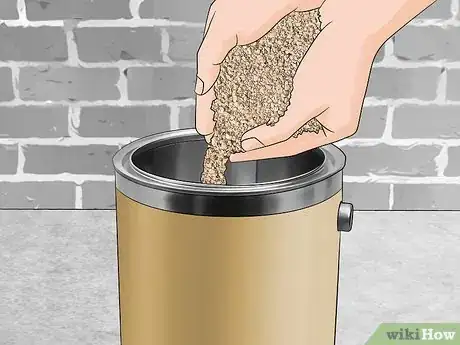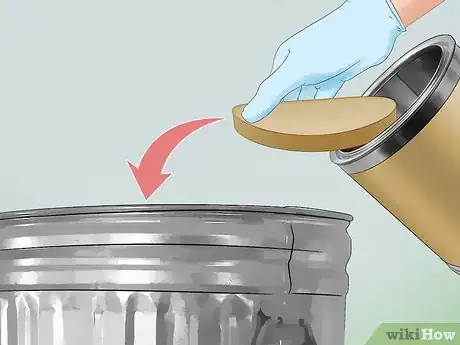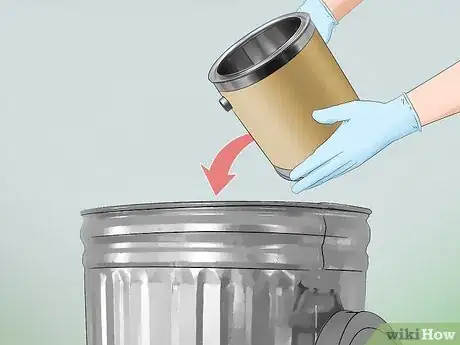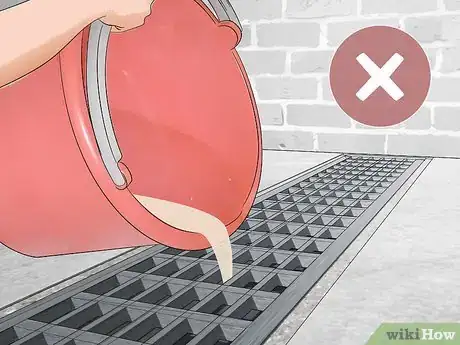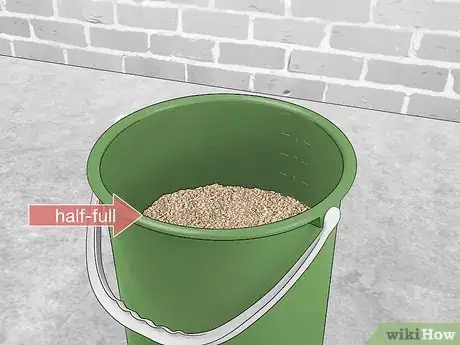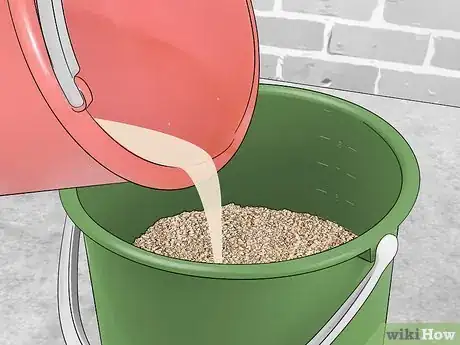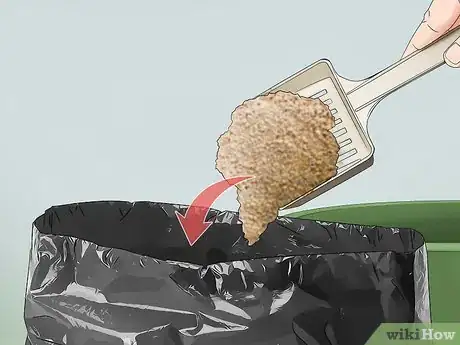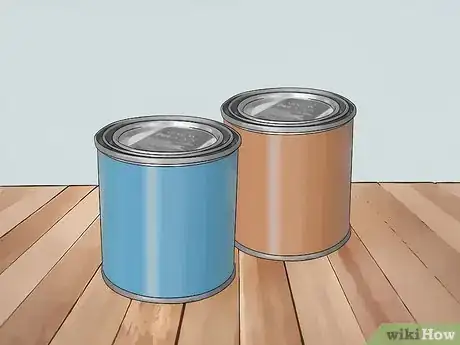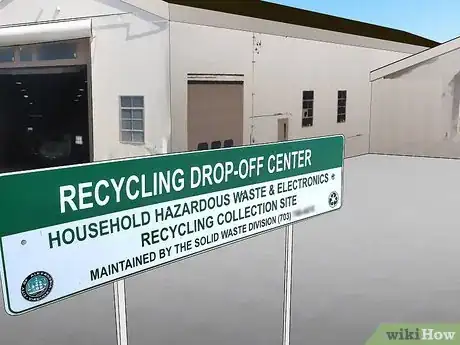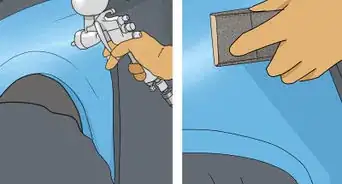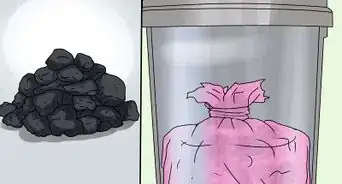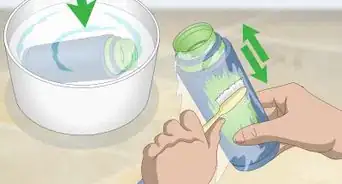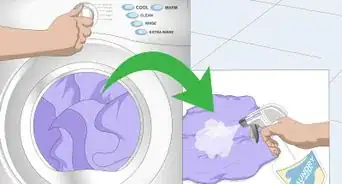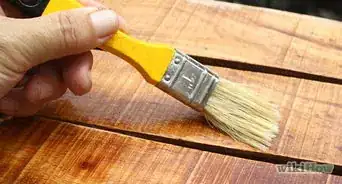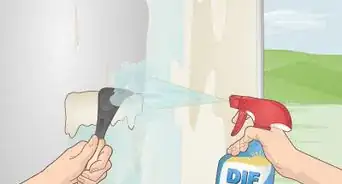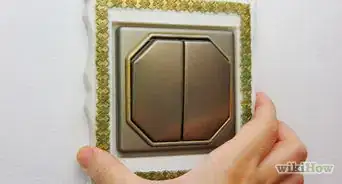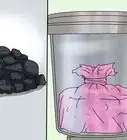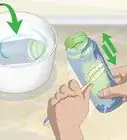This article was co-authored by Jeff Baldwin and by wikiHow staff writer, Jessica Gibson. Jeff Baldwin is a Residential Painter and the Owner of Baldwin Custom Painting. With two decades of painting experience, Jeff specializes in high-end residential and small commercial painting projects. Dedicated to quality craftsmanship, Jeff and Baldwin Custom Painting provide bonded/insured, licensed, and lead-safe certified services in residential painting, light commercial painting, and wood refinishing.
There are 9 references cited in this article, which can be found at the bottom of the page.
This article has been viewed 69,411 times.
Whether you've just completed a painting or finished painting the walls of your house, you'll probably have leftover acrylic paint. Instead of simply pouring the paint down the drain or in the trash, take a few steps to let it dry out first. You can safely dispose of hardened acrylic paint. Then, separate the acrylic paint from the rinse water before pouring the water down the drain.
Steps
Hardening the Paint for Disposal
-
1Do not pour liquid acrylic paint down the drain or into the trash. Most states and counties have strict laws about disposing of acrylic paint outside where it can end up in waterways. Never pour your acrylic paint down the sink, because the paint will clog up your pipes over time.[1] [2]
- You should also avoid pouring acrylic paint into the trash or throwing containers of liquid acrylic paint into the trash can. Most waste management companies require you to dispose of the paint first or let it harden before putting the container in the trash.
Did You Know? It's illegal to dump the acrylic paint into storm drains, local waterways, or outside on the ground. This is because the paint can harm wildlife and the ecosystem.
-
2Leave the paint to harden in the can if there's 1 inch (2.5 cm) or less left. To dispose of a small amount of paint that's left in the can, take the lid off and put the can in a well-ventilated space. If it's not humid or rainy in your area, set the container outside. Then, leave the paint for several days or weeks until it's completely solid.
- If you can't get the solid paint to come out of the container, throw it all away in the trash.
Advertisement -
3Mix cat litter into leftover paint to speed the drying time. If your container of paint is half full, pour an equal amount of cat litter into the container. Use a long wooden paint stirrer to mix the cat litter into the paint so it thickens and looks chunky. Set the can out for about 1 hour or until the paint firms up.[3]
- If you have even more paint left in the container, pour it all into a 5 US gal (19 L) bucket and add an equal amount of cat litter. Then, let it harden.
-
4Remove the hardened or thickened paint and toss it in your regular trash. If you dried the paint in the can, use a long metal spoon to pry the hardened disc of paint out. You can throw this hardened paint into the trash can. If you used cat litter to thicken the paint, spoon the mixture into the trash.
-
5Throw away or recycle empty paint containers. Once you've disposed of the acrylic paint, let the paint can dry completely. Then, take it to a recycling roundup or toss it in the trash with your other waste. Keep in mind that most waste management companies will only accept cans that are 5 gallons (19 L) in size or smaller.[4]
- There's no need to wash out the can, but it needs to be empty and dry.
Getting Rid of Acrylic Paint Water
-
1Avoid pouring acrylic rinse water down the drain. The water you used to rinse brushes or paint rollers contains all of the acrylic paint that was in the brush or roller. To prevent this paint from getting into the water system or clogging your pipes, never pour the rinse water directly down the drain.
- You should also avoid pouring the rinse water on the ground, into a storm drain, or into a local waterway.
-
2Fill a clean bucket half-full with cat litter or sand. Set a 5 US gal (19 L) bucket near your painting supplies. Then, pour in enough clean cat litter to come halfway up the side of the bucket. You can use clumping or non-clumping cat litter.[5]
- If you prefer, you could use sand instead of kitty litter, but you'll need to let the rinse water evaporate over several days or weeks.
-
3Pour the rinse water into the bucket. Slowly pour all of your containers of rinse water into the cat litter or sand. You'll see the acrylic pigment settle on top of the cat litter while the water is absorbed.[6]
Tip: You can fill a smaller container with cat litter if you use acrylic paint for art projects. Set it near your easel, so you can pour in the rinse water as soon as you've finished painting for the day.
-
4Throw away the cat litter once it clumps or becomes wet. Use a slotted spoon or a clean cat litter scoop to scoop up the cat litter with pigment. If you used clumping cat litter, scoop up the clumps. Then, put the cat litter into a plastic bag. Seal it shut and throw the bag in the trash.[7]
- You can continue to use the cat litter that's left in the bucket. Pour new cat litter into the bucket if the mixture begins to look watery.
Donating Excess Paint
-
1Purchase just enough acrylic paint for your project. To reduce the amount of acrylic paint you're disposing of or donating, buy only as much as you need for each project. You should also thoroughly scrape the paint off of your brushes once you're done painting.[8]
- Consider saving some of your acrylic paint for touching up walls.
-
2Search for a household waste roundup in your community. Many communities have designated places where you can drop off acrylic paint that you no longer need. In some cases, you might need to pay a small fee so ask when you drop the paint off.[9]
- Check with the store where you purchased the acrylic paint. Some stores will accept the leftover paint and recycle it for you.[10] Depending on where you live, you might have even paid a recycling fee when you bought the paint.
-
3Donate leftover paint to a group in your community. If you have lots of paint leftover or several small containers, ask neighbors, local schools, community centers, or nonprofit groups in your area if they could use it. Art groups and drama clubs frequently need acrylic paint and they'd appreciate your donation.
- If you seal the container tightly, acrylic paint can last up to 5 years.
Expert Q&A
-
QuestionIs acrylic paint safe to go down the drain?
 Jeff BaldwinJeff Baldwin is a Residential Painter and the Owner of Baldwin Custom Painting. With two decades of painting experience, Jeff specializes in high-end residential and small commercial painting projects. Dedicated to quality craftsmanship, Jeff and Baldwin Custom Painting provide bonded/insured, licensed, and lead-safe certified services in residential painting, light commercial painting, and wood refinishing.
Jeff BaldwinJeff Baldwin is a Residential Painter and the Owner of Baldwin Custom Painting. With two decades of painting experience, Jeff specializes in high-end residential and small commercial painting projects. Dedicated to quality craftsmanship, Jeff and Baldwin Custom Painting provide bonded/insured, licensed, and lead-safe certified services in residential painting, light commercial painting, and wood refinishing.
Residential Painter You should never rinse acrylic paint down the drain since it can contaminate the water.
You should never rinse acrylic paint down the drain since it can contaminate the water. -
QuestionCan I recycle acrylic paint?
 Jeff BaldwinJeff Baldwin is a Residential Painter and the Owner of Baldwin Custom Painting. With two decades of painting experience, Jeff specializes in high-end residential and small commercial painting projects. Dedicated to quality craftsmanship, Jeff and Baldwin Custom Painting provide bonded/insured, licensed, and lead-safe certified services in residential painting, light commercial painting, and wood refinishing.
Jeff BaldwinJeff Baldwin is a Residential Painter and the Owner of Baldwin Custom Painting. With two decades of painting experience, Jeff specializes in high-end residential and small commercial painting projects. Dedicated to quality craftsmanship, Jeff and Baldwin Custom Painting provide bonded/insured, licensed, and lead-safe certified services in residential painting, light commercial painting, and wood refinishing.
Residential Painter Check for a hazardous recycling center in your area to see if they accept acrylic paint.
Check for a hazardous recycling center in your area to see if they accept acrylic paint.
Warnings
References
- ↑ Jeff Baldwin. Residential Painter. Expert Interview. 26 February 2021
- ↑ https://www.kauai.gov/hhw
- ↑ https://youtu.be/fAxFDJzjBFE?t=82
- ↑ https://youtu.be/d8l9FFLyjJU?t=117
- ↑ https://youtu.be/sG_wXxu7W0o?t=349
- ↑ https://youtu.be/sG_wXxu7W0o?t=378
- ↑ https://youtu.be/sG_wXxu7W0o?t=403
- ↑ https://vancouver.ca/files/cov/green-painting-guide.pdf
- ↑ https://www.epa.gov/hw/household-hazardous-waste-hhw
- ↑ Jeff Baldwin. Residential Painter. Expert Interview. 26 February 2021
- ↑ https://vancouver.ca/files/cov/green-painting-guide.pdf
- ↑ https://www.kauai.gov/hhw
- ↑ https://www.kauai.gov/hhw
